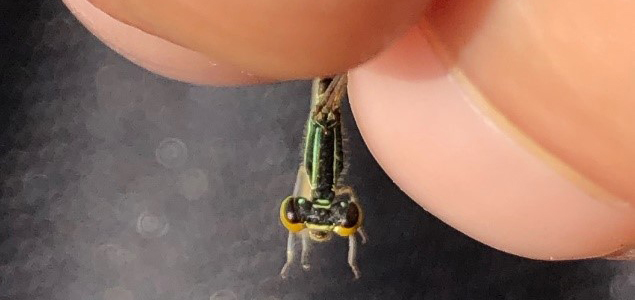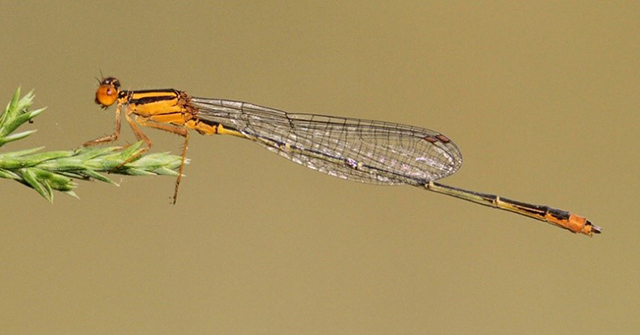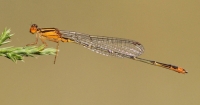Perhaps it’s the feeling of catching a hearty dragonfly in your net and feeling its powerful wings vibrating against the mesh or the way it’s possible to focus on an assortment of greenery and spot the small, delicate movements of a damselfly dancing among the foliage. Maybe it’s the way a Green Darner zones in on prey and tackles it mid-air. Whatever the reason for the captivation, dragon-hunting turns me into a cat, as if my pupils dilate and I am ready to pounce.
After the initial act of catching an individual comes the identification process. I can’t get enough of this part. Whether it is an easy ID that can be deciphered from a distance or a difficult ID that requires multiple people with multiple field guides to pick out shapes of particular cells in the wing venation or slight differences in the terminal appendages with 10x magnification, it’s all so very intriguing. It is inspiring to see the look on people’s faces when they see one of these creatures up close – realizing there’s a whole world of beauty and power (and not to mention, color) in a small, and otherwise mostly elusive, creature.
Notably, one of the most exciting finds from these past two summers at the UEC was that of the Citrine Forktail (Ischnura hastata) at the Urban Ecology Center’s Menomonee Valley branch. The Citrine Forktail is labeled a “most wanted” species in Wisconsin, meaning that we know it exists here (although few and far between) and we want to know more about it. This species has been found consecutively the past three years in the Menomonee Valley, and two of those times at “Dragonfly Pond.”

Citrine Forktail (Ischnura hastata)
I am constantly learning how to identify new-to-me species at this stage in my experience. In the case of last summer’s Citrine Forktail, I barely spotted its small body amidst the pond’s vegetation but I knew that it was something different from your average Eastern Forktail. Not only were the colors slightly different, but it was so TINY! With a sweep of my net, I thought I had caught the individual, only to find it had come back empty. My heart sunk, but my determination did not. Luckily, a group of volunteers was with me and one of them (with much better aim, mind you) was able to successfully net the damsel. We carefully extracted it and examined it with a loupe. Male? Check. Reddish stigma located off the leading edge of the forewing? Check. Eyespots? Check. Abdominal segments eight through ten yellow? Check. Tiny? Check! This was indeed a Citrine Forktail. I was elated – probably appearing a little crazy to those around me but once you’re sucked into the odonate world, I'm sure you can understand this excitement.
Another species that was fun to find was the Shadow Darner (Aeshna umbrosa). Personally, this was my first non-“Common Green” Darner sighting at the UEC, and it turned out to be the first Shadow Darner to be netted and identified at Riverside Park. It was mid-September and quite foggy, with temperatures hovering just over sixty degrees, so I wasn’t too hopeful we’d find much on our survey. I hadn’t thought of late-season species or those that even prefer shady (or foggy) environments. Not five minutes into the survey, the volunteer accompanying me netted an individual perched on a rock outside of the pond in front of the building.

Shadow Darner (Aeshna umbrosa)
Shadow Darners can be mistaken for a similar looking species, the Lance-Tipped Darner. These two Mosaic Darners have wedge-shaped cerci (paired appendages on the rear-most segment), so distinguishing factors are the size of their abdominal spots as well as the shape of their thoracic striping. The individual we identified was a female, and she had very narrow spots on her abdomen and no notch in her anterior thoracic stripe. Shadow Darners also typically have a black outline on the thoracic stripes, while the Lance-Tipped Darners do not.
When entering data from the survey, I was surprised to see that this had been the first of this species documented at Riverside Park. Another cool data point for the field season! This was especially rewarding on a day that I wasn’t expecting to find much. My eyes were reopened to the fact that odes are out and about in all sorts of conditions and, like the Shadow Darner, some species actually prefer shady conditions or less favorable weather. You never know when you might spot one!
The last highlight I’d like to make (otherwise I will never stop) is the Orange Bluet (Enallagma signatum), a damselfly species at we identified Washington Park. Looking back at our data, it appeared that this species had only been found once at Riverside Park back in 2014, so not only was this sighting at Washington Park at a new branch, it was also the first time in five years we had documented an Orange Bluet at any of the UEC sites. Even though the Orange Bluet is not a rare species and is quite widespread, it’s so exciting to see the richness of species grow as the UEC habitats are improved and revitalized.

Male Orange Bluet (Enallagma signatum), photo by Dan Jackson
This species belongs to the Bluet genus in the Pond Damsel family, which are notoriously difficult to identify. Most of them are blue, hence “Bluet—”, but there are many different color forms between species, sexes, and ages, and not all are as kindly named to describe their color as the “Orange Bluet”).
I am really looking forward to developing my expertise not only in identification but on the specifics of each family and species. Where do they like to fly? When do they like to fly? Where would I find the species’ nymphs? I can’t wait to delve into all things odonate, find more species, and to hopefully document the Citrine Forktail, Shadow Darner, and Orange Bluet again this year.
Please stay tuned in to our UEC In My Backyard - Backyard Research page where there will be ongoing Research and Community Science resources as well as various other activities. Also, go out and try your hand at photographing dragonflies! Much like birding, it is a great activity to get outside and appreciate wildlife while practicing safe physical distancing measures. If you have any questions with ID or otherwise, please email Maggie at This email address is being protected from spambots. You need JavaScript enabled to view it..
For more identification help and additional information, also check out the Wisconsin Dragonfly Society website and Facebook page.





